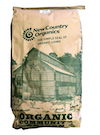February 7, 2018
2623 view(s)
We get a fair amount of questions regarding mineral ratios, particularly that of calcium (Ca) and phosphorus (P) in ruminants. New Country Organics follows the National Research Council's recommendations of keeping a 2:1 Ca:P ratio in livestock feeds and minerals. Without this balance in the diet, mineral imbalance can result in a variety of health problems.
Calcium is needed by the body in multiple ways such as bone development, blood clotting, milk production, nervous and muscular system functions, heart function, and cell interaction. Gestation and lactation require higher amounts of calcium in the diet to prevent cases of hypocalcemia (also known as parturient paresis or "milk fever") and to prevent the animal from pulling too much calcium from stored amounts in the body. Signs of hypocalcemia can vary according to severity, but the five most common symptoms are stiff gait, arthritis, ataxia, salivation, and constipation.
Phosphorus is needed by the body for fetal development, general bodily functions, and milk production. Signs of deficiency range from slow growth, failure to thrive, decreased appetite, and general unthriftiness. If fed too much grain and not enough forage, it is possible for ruminants to have an inverted ratio with more phosphorus than calcium, which can lead to urinary calculi (mineral deposits in the urine that are typically comprised of phosphate salts). Since phosphorus is mostly excreted in saliva, feeding a quality dry hay helps to keep phosphorus levels in the correct range, as more saliva is needed to break down the feed. Castrated males that are castrated before reaching sexual maturity are at greater risk of developing urinary calculi. In small ruminants, it is generally recommended to not castrate before 7 weeks of age in order to allow the urethra sufficient time to develop.
While the 2:1 Ca:P ratio is important, one must not forget the importance of magnesium (Mg). Magnesium directly interacts with calcium and vice versa, thus they must be kept in the proper ratio for the body to function properly. Too much of one mineral over the other will cause a mineral deficiency to occur. Magnesium deficiency has been an ongoing problem in the United States for almost two decades. Magnesium is critical for proper bone development and, much like calcium, is also needed for enzyme, nervous, and muscular system functions. Magnesium is also needed for carbohydrate metabolism. Signs of deficiency vary in severity, but the most common symptoms are grass tetany, mastitis, excessive nervous behavior, and most of the symptoms also related to calcium deficiency. The ratio of Ca:Mg is also generally recommended to be kept at a 2:1 ratio.
While these minerals are important, these are just a few examples of many to show why minerals are a key part of an animal's diet. Mineral imbalances can be avoided by providing a well-balanced diet with good quality forage, a properly balanced free-choice mineral, and plenty of clean water. For more information on our line of Kelp-Based, Free-Choice Healthy Minerals, visit our website at http://wordpress.test/shop/animal-health/healthy-minerals.html.
If you have any questions, please feel free to contact our Customer Care team at 540-469-0694 and we would be happy to discuss animal nutrition with you!
Resources:
Coleby, Pat. Natural Goat Care. 1st ed., Acres U.S.A., 2001.
“Nutritional Requirements of Goats - Management and Nutrition.” Merck Veterinary Manual, www.merckvetmanual.com/management-and-nutrition/nutrition-goats/nutritional-requirements-of-goats.
“Parturient Paresis in Sheep and Goats - Metabolic Disorders.” Merck Veterinary Manual, www.merckvetmanual.com/metabolic-disorders/disorders-of-calcium-metabolism/parturient-paresis-in-sheep-and-goats.
Pond, W. G., et al. Basic animal nutrition and feeding. 5th ed., Wiley, 2005.
Saha, Uttam Kamar, et al. Mineral Supplements for Beef Cattle. UGA Cooperative Extension, 1 June 2010, extension.uga.edu/publications/detail.html?number=B895. Calcium and Phosphorus: Why is there a 2:1 ratio?
Search the blog
My Wish Lists


